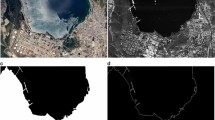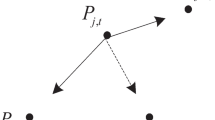Abstract
While executing tasks such as ocean pollution monitoring, maritime rescue, geographic mapping, ship localization, cruise missile guidance and automatic navigation utilizing remote sensing images, the coastline feature should be determined. Traditional methods are not satisfactory to extract coastline in high-resolution panchromatic remote sensing image. Active contour model, also called snakes, have proven useful for interactive specification of image contours, so it is used as an effective coastlines extraction technique. Firstly, coastlines are detected by water segmentation and boundary tracking, which are considered initial contours to be optimized through active contour model. As better energy functions are developed, the power assist of snakes becomes effective. New internal energy has been done to reduce problems caused by convergence to local minima, and new external energy can greatly enlarge the capture region around features of interest. After normalization processing, energies are iterated using greedy algorithm to accelerate convergence rate. The experimental results encompassed examples in images and demonstrated the capabilities and efficiencies of the improvement.
Access this chapter
Tax calculation will be finalised at checkout
Purchases are for personal use only
Similar content being viewed by others
References
Niedermeier A, Romaneeen E, Lehner S. Detection of coastlines in SAR Images using wavelet method. IEEE Trans. on Geoscience and Remote Sensing, 2000. 38(5): 2270–2281.
Karantzalos K G, Argialas D, Georgopoulos A. Towards automatic detection of coastlines from satellite imagery. In: Proceedings of 14th International Conference on Digital Signal Processing, Santorini, Greece, 2002(2). 897–900.
Lu Liming, Wang Runsheng, Li Wugao. A method of coastline extraction from synthetic aperture radar raw-data. Journal of Software, 2004, 16(6): 531–53.
Frazier P S, Page K J, Water body detection and delineation with Landsat TM data. Photogrammetric. Engineering and remote sensing, 2000, 66(12): 1461–1467.
Kevin W, Elasmar H M. Monitoring changing position of coastlines using thematic mapper imagery, an example from the Nile Delta. Geomorphology, 1999, 29(1–2): 93–105.
Jing Hao, Chen Xuequan, Gu Zhiwei. A method for coastline extraction based on edges. Computer simulation, 2006, 23(8): 89–93.
Kass M, Witkin A, Terzopoulos D. Snakes: Active contour models. International Journal of Computer Vision, 1987, 1(4): 321–331.
Li Peihua, Zhang Tianwen. Review on active contour model(Snake model). Journal of Software, 2000, 11(6):751–757.
Cohen L D, Cohen I. Finite-element methods for active contour models and balloons for 2-D and 3-D images. IEEE Trans. on Pattern Analysis and Machine Intelligence, 1993, 15(11): 1131–1147.
Xu C, Prince J L. Snakes, shapes, and gradient vector flow. IEEE Trans. on Image Processing, 1998, 7(3): 359–369.
Williams D J, Shah M. A fast algorithm for active contours and curvature estimation. CVGIP: Image Understanding, 1992, 55(1): 14–26.
Wang X N, Feng Y J, Feng Z R. Ant colony optimization for image segmentation. In: Proceedings of the 4th International Conference on Machine Learning and Cybernetics, Guangzhou, China, 2005, 5355–5360.
Oliveira A, Ribeiro S, Esperanca C, Giraldi G. Loop snakes: the generalized model. In: Proceedings of the 9th International Conference on Information Visualisation, Washington, DC, USA, 2005, 975–980.
Pal S K. Automatic graylevel thresholding through index of fuzziness entropy. Pattern Recognition Letters, 1983(1): 141–146.
Wu Fan, Wang Chao, Zhang Hong, Zhang Bo, Zhang Wei-sheng. Knowledge-based bridge recognition in high resolution optical imagery. Journal of Electronics & Information Technology, 2006, 28(4):587–591.
Amini A A, Tehrani S, Weymouth T E. Using dynamic programming for minimizing the energy of active contours in the presence of hard constraints. In: Proceedings of 2nd Int. Conf. Computer Vision, Los Alamitos, CA, USA, 1988, 95–99.
Author information
Authors and Affiliations
Corresponding author
Editor information
Editors and Affiliations
Rights and permissions
Copyright information
© 2017 Springer International Publishing AG
About this paper
Cite this paper
Kun, X., Bing-xian, Z., Hong-yan, H. (2017). A Method of Coastline Detection from High-Resolution Remote Sensing Images Based on the Improved Snake Model. In: Urbach, H., Zhang, G. (eds) 3rd International Symposium of Space Optical Instruments and Applications. Springer Proceedings in Physics, vol 192. Springer, Cham. https://doi.org/10.1007/978-3-319-49184-4_41
Download citation
DOI: https://doi.org/10.1007/978-3-319-49184-4_41
Published:
Publisher Name: Springer, Cham
Print ISBN: 978-3-319-49183-7
Online ISBN: 978-3-319-49184-4
eBook Packages: Physics and AstronomyPhysics and Astronomy (R0)




